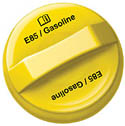Sweden Serves as Ethanol Model
 Sweden has embraced ethanol unlike any other country outside Brazil and the Nordic nation’s example may help the United States in its quest to reduce its dependence on foreign oil.
Sweden has embraced ethanol unlike any other country outside Brazil and the Nordic nation’s example may help the United States in its quest to reduce its dependence on foreign oil. How committed is Sweden, a small country with just 4.2 million cars?
Last year, it began converting beer, wine and hard alcohol smuggled in to the country into biofuel used to power trucks and buses. Many Swedes attempt to bring alcohol home because taxes are lower in continental Europe. In 2007, Sweden turned 180,000 gallons of alcohol into biofuel.
“Some vodka distilleries are switching to ethanol production, said Bo Andersson, a Swedish native and General Motors Corporation’s (GM) vice president for global purchasing, “and some paper mills in northern Sweden are working to develop cellulosic ethanol.”
“Sweden has made a major commitment to ethanol,” Michael Wood, the U.S. ambassador to Sweden and a Flint native, said in a recent interview in Detroit, Mi.
Michigan officials, including Gov. Jennifer Granholm, are looking to Sweden for guidance and see the push for alternative fuels there and the transformation in various industries as something which could be emulated here. The governor made a trip to Sweden last year and has praised the country’s commitment to alternative energy. She said Michigan must follow suit and is planning a summit of Michigan and Swedish energy leaders later this year in Michigan.
“To understand the connection between renewable energy and jobs, just look at Sweden, a country with striking resemblances to our state, having the same size population, similar geography with two-thirds of their land covered by forests and a strong automotive sector,” Granholm said. ” Sweden set high goals for their use of renewable energy. The result? They created more than 2,000 businesses and 400,000 jobs in their renewable energy sector.”
The United States has about 121 million drivers and just more than 1,200 E85 pumps, mostly in the Midwest. By contrast, Sweden has 5 million drivers, but more than 1,000 ethanol pumps, in part because of a 2006 Swedish law which requires stations to have an alternative fuel pump.
Last year, Ford Motor Company’s Volvo unit and a U.S. hedge fund invested $10 million in an experimental cellulosic ethanol plant in Sweden.
At the Detroit auto show last month, GM announced it had invested in Warrenville, Ill., cellulosic research firm Coskata, Inc. In December, 80 percent of the vehicles sold by GM’s Saab unit were flex-fuel capable, said Christer Nilsson, a Saab spokesman in Sweden.
“The approach has been to coordinate all actors to start the journey at the same time, marching together,” Nilsson said. “The cars are of no need if there are no pumps and vice versa.”
About 12 percent of vehicles sold in Sweden in 2007 were E85 models, versus an expected 6 percent in the United States.
Sweden has also taken financial steps to encourage E85 vehicles where the United States has not. Those vehicles qualify for a 20 percent tax break and many local governments give flex-fuel vehicles free parking. Those benefits have been extended to gasoline-electric hybrid vehicles in some U.S. cities, but not to the 6 million flex-fuel vehicles on the roads today.
Last March, the Swedish government also gave flex-fuel vehicle buyers a $1,500 rebate and there is no tax on E85 at the pump. Granholm has called for the elimination of Michigan’s $0.12-cent per gallon tax on E85.
Some automakers in Sweden have pitched in, too. Volvo gives customers a rebate when they trade in a gasoline-powered vehicle for a flex-fuel one in Sweden.
Further evidence of the commitment is the pressure by some political parties in Sweden to ban any non-environmentally-friendly car from being sold after 2015.
The rest of Europe is starting to embrace ethanol, though outside of Sweden there are only 375 E85 pumps. Scottish whisky distilleries want to make ethanol out of waste material. Last year Great Britain opened its first ethanol plant from sugar beets, while France wants 7 percent of all its fuel to come from ethanol by 2010.
The United States has taken a different approach to getting ethanol to the pumps. The energy bill boosting fuel economy standards which became law in December requires the nation use 36 billion gallons of ethanol by 2022, including 21 billion gallons of cellulosic ethanol, but it doesn’t regulate how to get there.
Americans spend $1 billion a day to consume about 388 million gallons of gasoline. In 2006, Americans used 5.4 billion gallons of ethanol. Under the new law, the United States must use 9 billion gallons of ethanol in 2008.
The quick ramp up of ethanol use has drawn concerns from one of the energy bill’s main authors, Sen. Jeff Bingaman, D-N.M., chairman of the Senate energy and natural resources committee. “Early year biofuel requirements could be too aggressive,” he said.
Since the vast majority of ethanol in the United States comes from corn, diverting more corn to ethanol has led to its price more than doubling.
“If we cannot produce enough ethanol and biodiesel to meet these aggressive mandates, while maintaining food and fuel prices that consumers can afford, the biofuel industry will be tarnished,” Bingaman said last week. “The cost of failure is high.”
But Bruce Dale, a professor of chemical engineering at Michigan State University and an expert on ethanol, said Congress was right to set tough goals and the United States can learn from Sweden.
“Otherwise, we’re going to muddle along for a long time,” Dale said. “How much longer do we want to be dependent on $100-a-barrel oil that’s crippling us?”
Source: The Detroit News
You can return to the main Market News page, or press the Back button on your browser.

